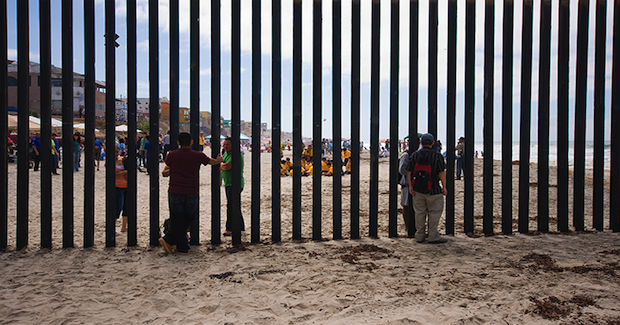The US-Mexico Borderlands

Donald Trump’s promise to build a wall between the US and Mexico was a hallmark of the recent election campaign. What lies at the root of this proposal? And what would the impact of such a structure be on those that live in the borderlands?
Trump’s presidential campaign, from its inception, attacked Mexican people living on either side of the border. His 2015 tweet, “I love the Mexican people, but Mexico is not our friend. They’re killing us at the border and they’re killing us on jobs and trade” is just one of many examples of the rhetoric he used to garner support and spread misinformation during his incendiary campaign.
The impact of his election has been felt far and wide, however his coming presidency raises particular concerns for US-Mexico border communities, communities that have been experiencing what sociologist Timothy Dunn has described as a “low-intensity conflict” since the late 1970s.
The militarisation has been increasingly felt since the mid-1990s. In what may be the biggest contradiction of the global market, just as capital and goods were able to freely cross national borders with the North American Free Trade Agreement, bodies became increasingly policed under the Clinton administration’s Operation Gatekeeper along the San Diego/Tijuana corridor and Operation Hold the Line in Texas.
Many concerns have been raised about Trump’s proposed border wall; however, those who would be the most affected are the people who live, work, go to school, and build families and community along the 2,000 mile-long (3,200 km) stretch. We must remember that the border is not just a site of passage but also a place of residence. These are communities that have already witnessed the growing technologies and weaponry, border agents and build-up of the last 20 years—realities that impact their everyday lives.
In 2010, border agents at the San Ysidro Port of Entry beat and discharged a Taser multiple times on Anastasio Hernandez Rojas, a long-time San Diego resident, which led to his untimely death. In 2012, a border agent standing behind the border fence in Nogales, Arizona, shot and killed 16-year-old Jose Antonio Elena Rodriguez, who was walking along a sidewalk in Nogales, Sonora. The agent claims he acted in self-defence against rock-throwers on the other side. When Trump supporters chant “build the wall, build the wall” are they imagining the heightened tensions that will affect the lives of border dwellers?
In addition to the numerous concerns being raised about the impact that Trump’s border wall will have on human rights, we should also ask: why a border wall, and why now? Would a wall, however unlikely and impractical, actually have a significant impact on immigration to the US from Mexico? The answer is that Trump’s promise to build a wall between the US and its neighbour to the south comes at a time when Mexican migration to the US is at its lowest point in more than two decades.
Many researchers actually claim that since the Great Recession, migration to the US from Mexico is at net zero, while the Pew Research Center finds that between 2009 and 2014, migration from Mexico saw a net loss of 140,000. The truth of the matter is that Trump’s border wall fantasy, like much anti-immigrant rhetoric over the course of US history, is less about actual immigration and economic trends, and more about nativism, xenophobia and anti-Mexican racism.
Many local and national immigrant, human, and civil rights organisations have issued statements, held town halls, and mobilised in the streets to make their opposition to Trump’s anti-immigrant rhetoric visible and known. In addition to strategising how to combat Trump’s potential policies and the wave of hate crimes that his looming presidency has inspired, communities are also learning how to come together in the face of a common threat.
One particular community that can teach us all about resisting and surviving border militarisation and violence is the Tohono O’odham Nation. The Tohono O’odham have lived in what is now considered the US Southwest and Mexican Northwest for thousands of years. As a result, they have borne the brunt of US border politics since their land was annexed by the US in 1853 and their community was literally and violently cut in half.
The negative effects of US immigration policy on the Tohono O’odham have been escalating in recent years with the militarisation of the border region during the Bill Clinton era and then ramped up under the Obama administration. According to the official website of the Tohono O’odham Nation, “On countless occasions, the US Border Patrol has detained and deported members of the Tohono O’odham Nation who were simply traveling through their own traditional lands, practicing migratory traditions essential to their religion, economy and culture.”
It should then be no surprise then that the Tohono O’odham have vowed to resist Trump’s border wall. In the days following the presidential election, Vice Chairman Verlon Jose stated in an interview with a local radio station, “Over my dead body will a wall be built. I don’t wish to die, but I wish to work together with people so we can truly protect the homeland of this place they call the United States of America, not only for my people, not only for our Tohono O’odham Nation members, but for the American people.”
In thinking about the future of US relations with Mexico we think it is important to acknowledge the history between these two nations—a history rooted in colonialism, land grabs and a long-standing desire for cheap labour on behalf of the US agricultural industry that has always belied US immigration policy. Moreover, presidents on both sides of the border have never cared to understand border communities, nor expressed any real concern for migrants, whose labour has supported the economies of both nations for generations. In fact, when Mexico’s president Enrique Peña Nieto met with Trump in October of this year, there was no real critique of the aforementioned border wall, his only comment being that Mexico would “not pay for it”.
Instead of worrying about Trump’s rhetoric or the Mexican government’s response we think it is instructive to recognise and support the border communities that have been resisting, organising and imagining alternative ways of existing and thriving in the border region for centuries.
Michelle Téllez and Maurice R. Magaña are assistant professors of Mexican American studies at the University of Arizona.




